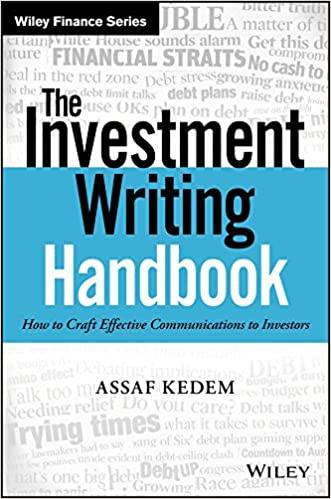Question
Family information: Sharon, age 29, married, has a 3-year-old son, is the only breadwinner of her family. Sharon earns $70,000 annually as a loan officer.
Family information: Sharon, age 29, married, has a 3-year-old son, is the only breadwinner of her family. Sharon earns $70,000 annually as a loan officer. Sharon is concerned about the financial well-being of her son if she should die. She would also like to start a savings program to send her son to the college. She is currently renting an apartment but she would like to buy a home someday. She is considering buying life insurance to help her situation. Her current budget for life insurance is limited, but as a loan officer, her income growth in the future is promising. Assume you are a financial planner and you are about to make recommendations to Sharon regarding the type of life insurance that Sharon should buy. The following types of life insurance policies are available from your company:
- 10-year convertible term
- Ordinary Life
- Traditional whole life paid-up-at age-65 (35 years pay)
- Universal life
1. Which of these life insurance policies would best meet the need for protection of Sharons son if she should die prematurely? Explain your answer.
2. Which of these life insurance policies would best meet the need to accumulate a college fund for Sharons son? Explain your answer.
3. Which of these life insurance policies would best meet the need to accumulate money for a down payment on a home? Explain your answer.
4. What major obstacle does Sharon face if she tries to meet all of her financial needs by purchasing cash-value life insurance?
5. Assume that Sharon decides to purchase the 10-year convertible term policy in the amount of $500,000. The policy has no cash value. Identify a basic characteristic of this term policy that would help Sharon accumulate a fund for retirement.
Part I-2. Answer the following questions:
6. Carl would like to purchase life insurance. He would also like to invest in a mutual fund. An agent told Carl about a form of life insurance in which Carl could select where the saving component is invested. This form of life insurance has fixed premiums, and the cash value is not guaranteed. What type of life insurance the agent is suggesting?
7. Carl does not like the life insurance policy without cash value guaranty. Instead, he purchased a life insurance policy in which a minimum interest rate is guaranteed on the cash value, and additional interest may be credited based on the investment performance of a group of common stocks. There is also a cap on the additional interest credited to the policy. Based on this information, what type of life insurance did Carl purchase?
8. Carls friend, Jose, likes the idea of having a life insurance policy in which he could select where the premium and saving component are invested. He is also willing to take the risk that cash value in the policy is not guaranteed, but he would like to have some flexibility in premium payments. What type of life insurance would you recommend to Jose?
9. Richard, age 35, is married and has three little kids. He is considering the purchases of additional life insurance to pay off the mortgage on his home, which has 25 years remaining. Please recommend a type of life insurance that is economical and will help meet Richards goal of mortgage payment.
10. In addition to the mortgage payment, Richard also wants to accumulate a sizable retirement fund, provide a payment of monthly income to his family if he should die and pay college expenses when the children reach college age. Richard does not know much about life insurance and investment. He just wants a policy with no investment risk, with guaranteed cash value, and a fixed premium payment, and if he pays the premium on time, he does not need to worry about the lapse of the policy. What type of life insurance would you recommend to Richard in this case?
Part II. Life insurance contract provisions
Kelly, age 29, recently purchased a $500,000 ordinary life insurance policy on her life. The waiver-of-premium rider and guaranteed purchase option are attached to the policy. For each of the following situations, indicate the insurers obligations, if any, to Kelly or to Kellys beneficiary. Identify the appropriate policy provision or rider that applies in each case. Treat each event separately.
11. Kelly fails to pay the second annual premium due on January 1. She dies 15 days later.
12. Kelly committed suicide three years after the policy was purchased.
13. At Kellys death, the life insurer discovered that Kelly deliberately lied about her age. Instead of being 29 years old, as she indicated, she was actually 31 years old at the time the policy was purchased.
14. Two years after the policy was purchased, Kelly was told she has breast cancer. She is uninsurable but would like to get additional life insurance.
15. Kelly is seriously injured in an auto accident. After six months, she is still unable to return to work. She has no income from her job and the insurance premium payments are financially burdensome.
16. Kelly wants to retire and does not wish to pay the premium on her policy. Indicate the various options that are available to her.
17. Ten years after the policy was purchased, Kelly is laid off from her job. She is unemployed and is in desperate need of cash.
18. When Kelly applied for life insurance, she concealed the fact that she had a heart problem. She died five years later.
Step by Step Solution
There are 3 Steps involved in it
Step: 1

Get Instant Access to Expert-Tailored Solutions
See step-by-step solutions with expert insights and AI powered tools for academic success
Step: 2

Step: 3

Ace Your Homework with AI
Get the answers you need in no time with our AI-driven, step-by-step assistance
Get Started


